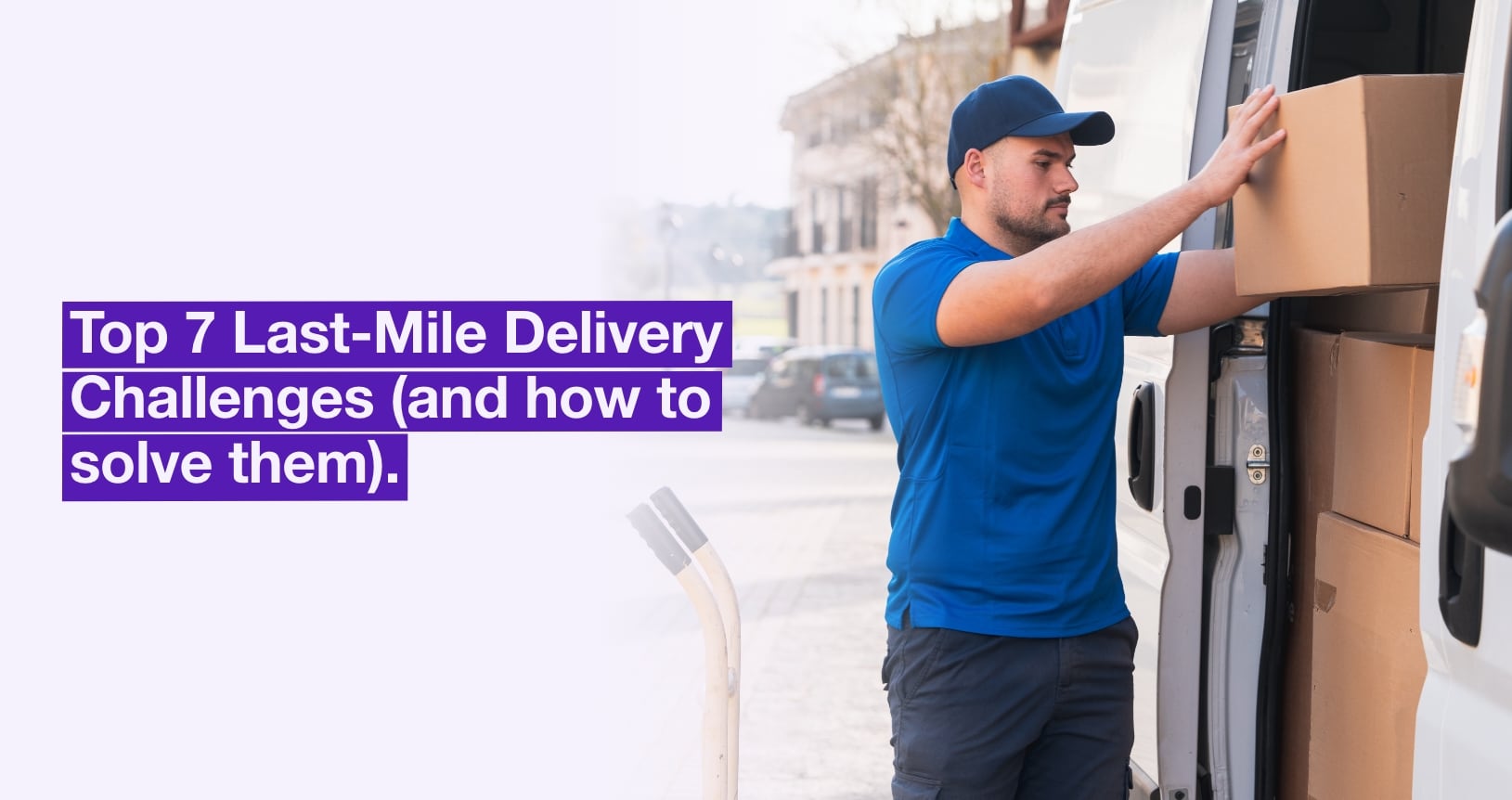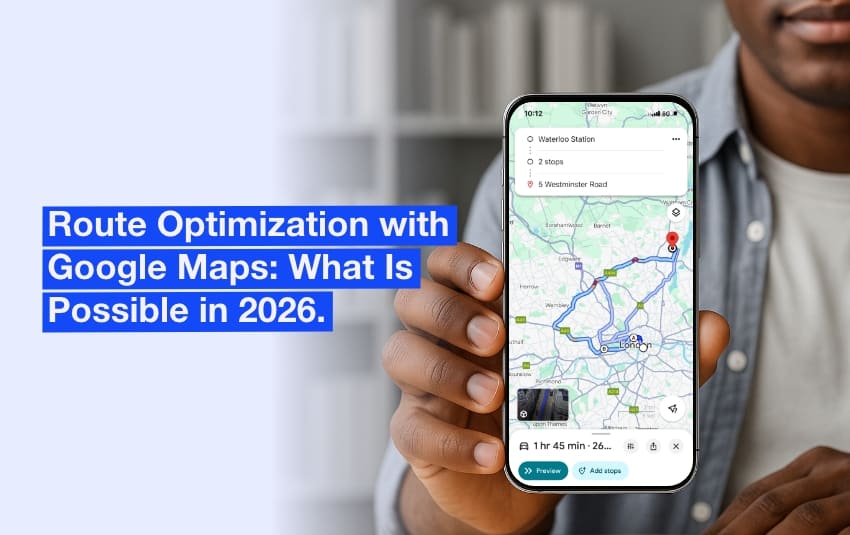Top 7 Last-Mile Delivery Challenges (and how to solve them)
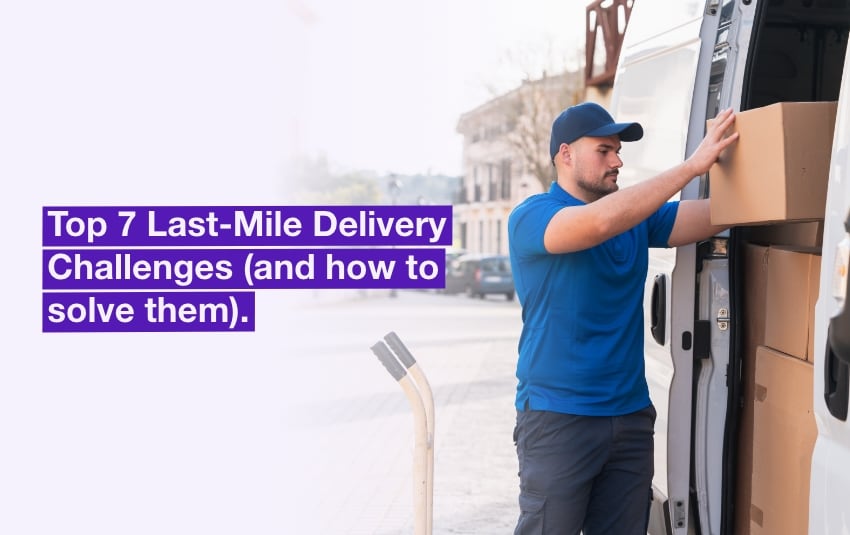
Imagine yourself in the hustle and bustle of a big city, late on a Friday. The streets are congested, scooters are weaving in and out of cars, and every minute counts.
In the midst of this urban cacophony, a simple parcel – perhaps a suit ordered online for an event the following day – absolutely must reach its destination on time. This is where the adventure of the ‘last mile’ begins, that short but complex segment of logistics.
In 2025, last-mile delivery has become the number one strategic challenge for many companies. Why is this? Because it alone accounts for more than 50% of total delivery costs (Capgemini Research), but also for the most significant part of customer satisfaction. Optimising this stage is no longer a luxury, but a necessity if you want to stand out in a world where ‘delivered tomorrow’ has become the expected norm.
In this article, we’re going to explore the 7 most common challenges of last-mile delivery, offering you concrete solutions for each one, inspiring examples and a few best practices drawn from our experience in the field.
Table of contents:
- High cost of last-mile delivery
- Pressures linked to customer expectations (fast, flexible delivery)
- Restricted access in urban areas
- Problems relating to failed deliveries
- Poor route planning
- Complex management of product returns
- Environmental pressures and societal expectations
1. High cost of last-mile delivery
Last-mile delivery is often compared to the home stretch of a marathon. It’s the shortest leg, but also the most exhausting and costly.
In logistics, this last stage sometimes represents more than 50% of the total cost of transporting a product. A paradox when you consider that this phase often covers less than 10% of the overall journey!
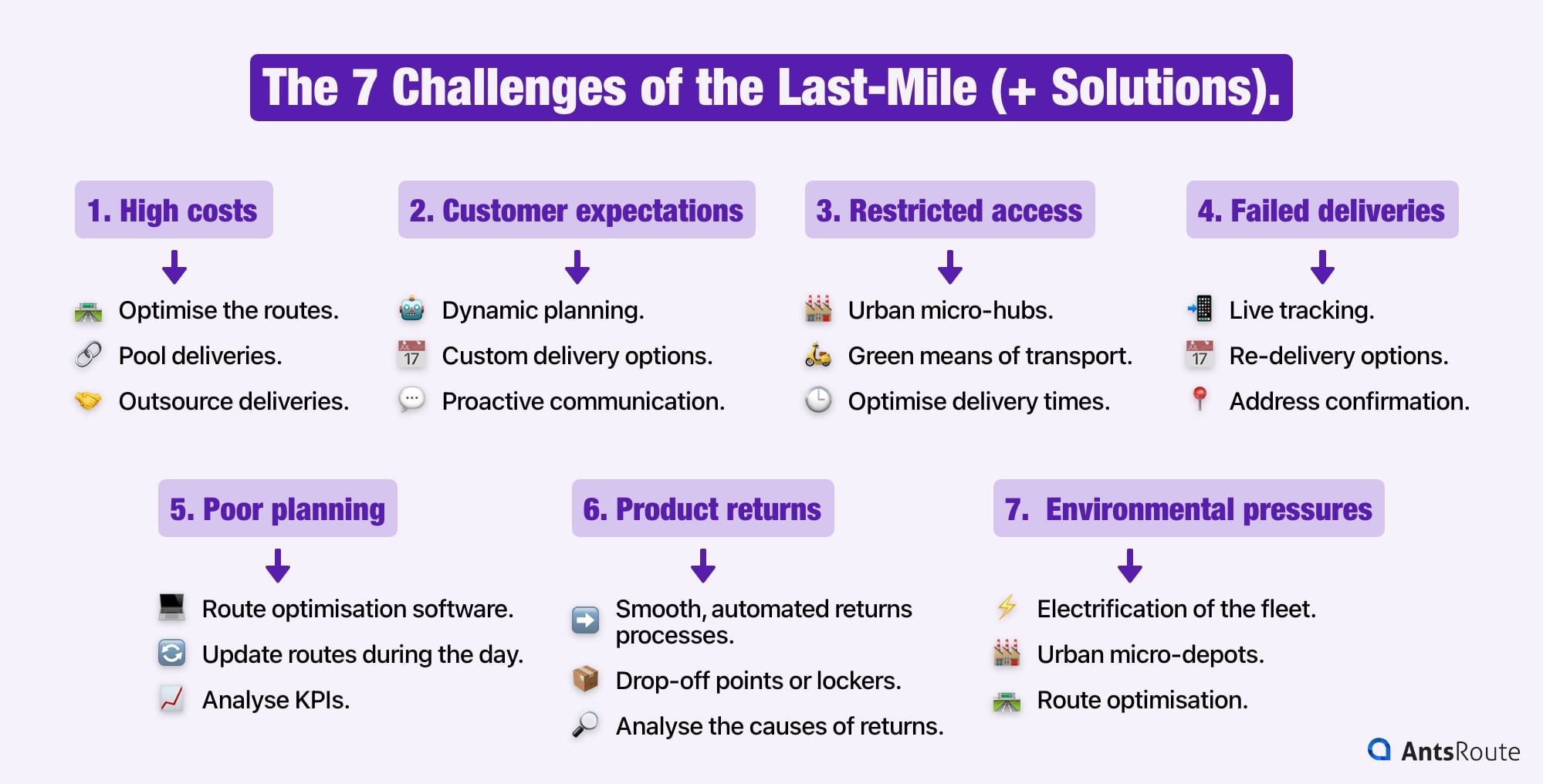
The 7 challenges of last-mile delivery (+ solutions).
Why are these costs soaring?
Urban delivery routes are particularly affected by:
- Low stop density (long distances for few parcels),
- Unpredictable traffic,
- Time wasted looking for parking spaces,
- Access restrictions in town centres.
Not to mention the fact that every extra minute spent in traffic jams or circling a city block is money down the drain – a bit like a logistics hourglass whose grains have been replaced by banknotes…
✅ How can you reduce these costs effectively?
- Optimise delivery routes using intelligent software capable of recalculating routes in real time according to traffic conditions.
- Pool deliveries by grouping nearby orders together to avoid unnecessary back-and-forth trips.
- Outsource certain deliveries to local partners who can respond more quickly in dense areas.
Solutions like AntsRoute, our SaaS route optimisation software, can automate planning and significantly reduce the costs associated with the final stages of delivery.
We invite you to discover our comparison of the best solutions available on the market in 2025.
☝️ An inspiring example
A food e-commerce player we are working with has managed to cut its costs by 18% by implementing a dynamic route optimisation system. The result: fuller lorries, shorter journeys and, above all, less stressed drivers – because, yes, behind every optimisation, there are also people who appreciate going home a little earlier.
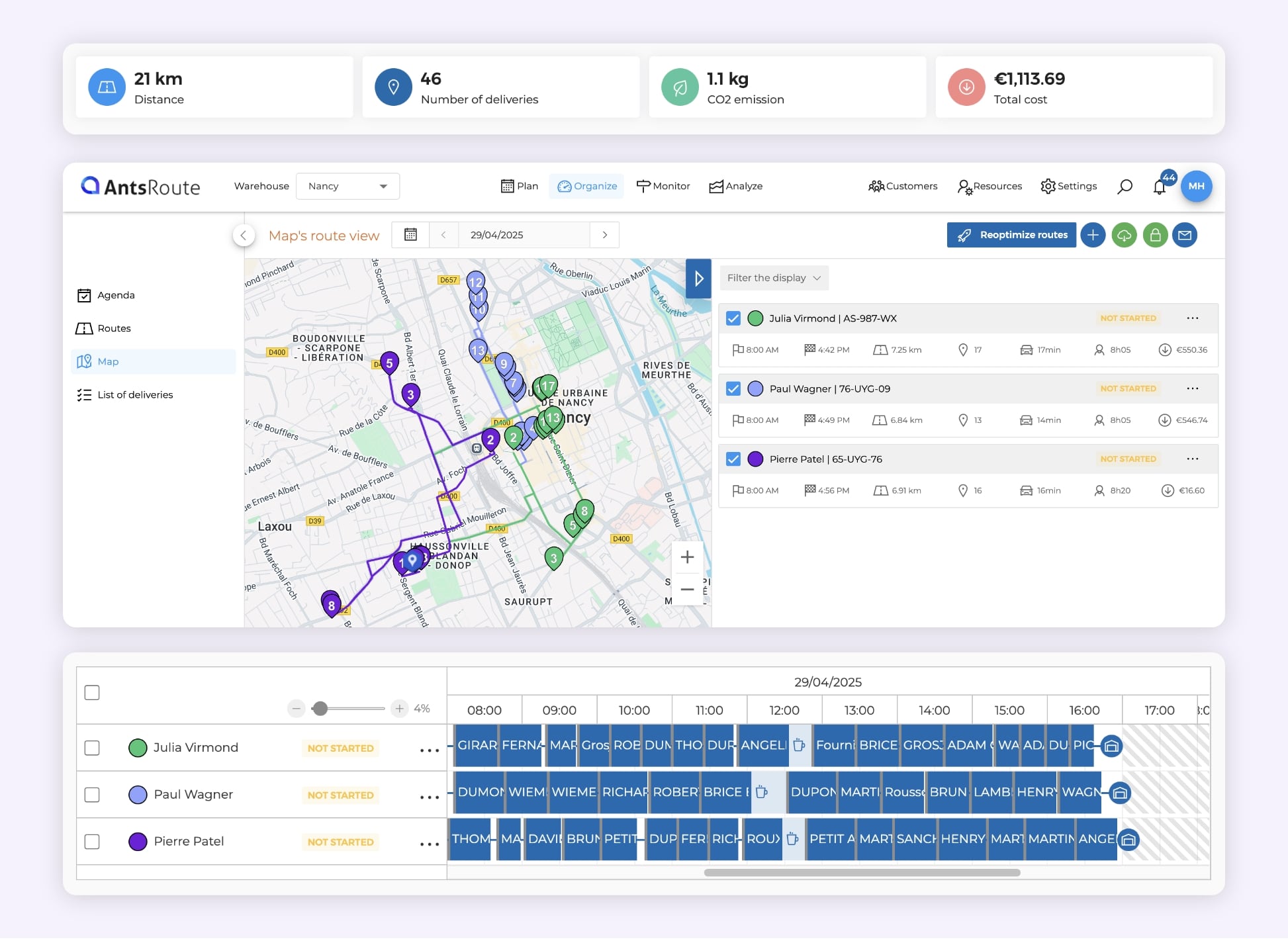
Optimising the delivery routes with AntsRoute.
2. Pressures linked to customer expectations (fast, flexible delivery)
In 2025, consumers’ delivery expectations are nothing like they were just a few years ago. We have entered the era of ‘logistics immediacy’. Today, offering 48-hour delivery seems almost outdated. The new standard is ‘delivered within a day’, or even ‘delivered within a few hours’.
This intense pressure comes directly from our own habits.
Without really realising it, we have all become impatient consumers. And our customers expect last-mile delivery to be as smooth and quick as ordering a takeaway coffee.
The main challenges facing professionals are numerous:
- Offering hyper-flexible delivery slots (evenings, weekends, one-hour slots).
- Adapting to last-minute changes without driving up costs.
- Communicating in real time with recipients to adjust delivery times.
A permanent dilemma arises: how to combine this quest for extreme speed with cost control and respect for human resources (drivers are not robots!).
✅ Concrete solutions to consider:
- Rely on dynamic planning: use algorithms capable of rescheduling routes in real time according to unforeseen events (traffic, cancellations, last-minute additions).
- Offer personalised delivery options: express delivery in city centres, click-and-collect, lockers.
- Communicate proactively with customers via SMS or mobile notifications to avoid missed appointments.
☝️ A concrete case:
A retail company specialising in electronic products introduced a system of flexible delivery slots. The result: their customer satisfaction rate rose by almost 20% in less than six months, simply by giving customers the power to choose where, when and how they received their parcels.
In short, by 2025, those who master the flexibility and speed of last-mile delivery will win not only market share, but also the hearts – and the loyalty – of their customers.
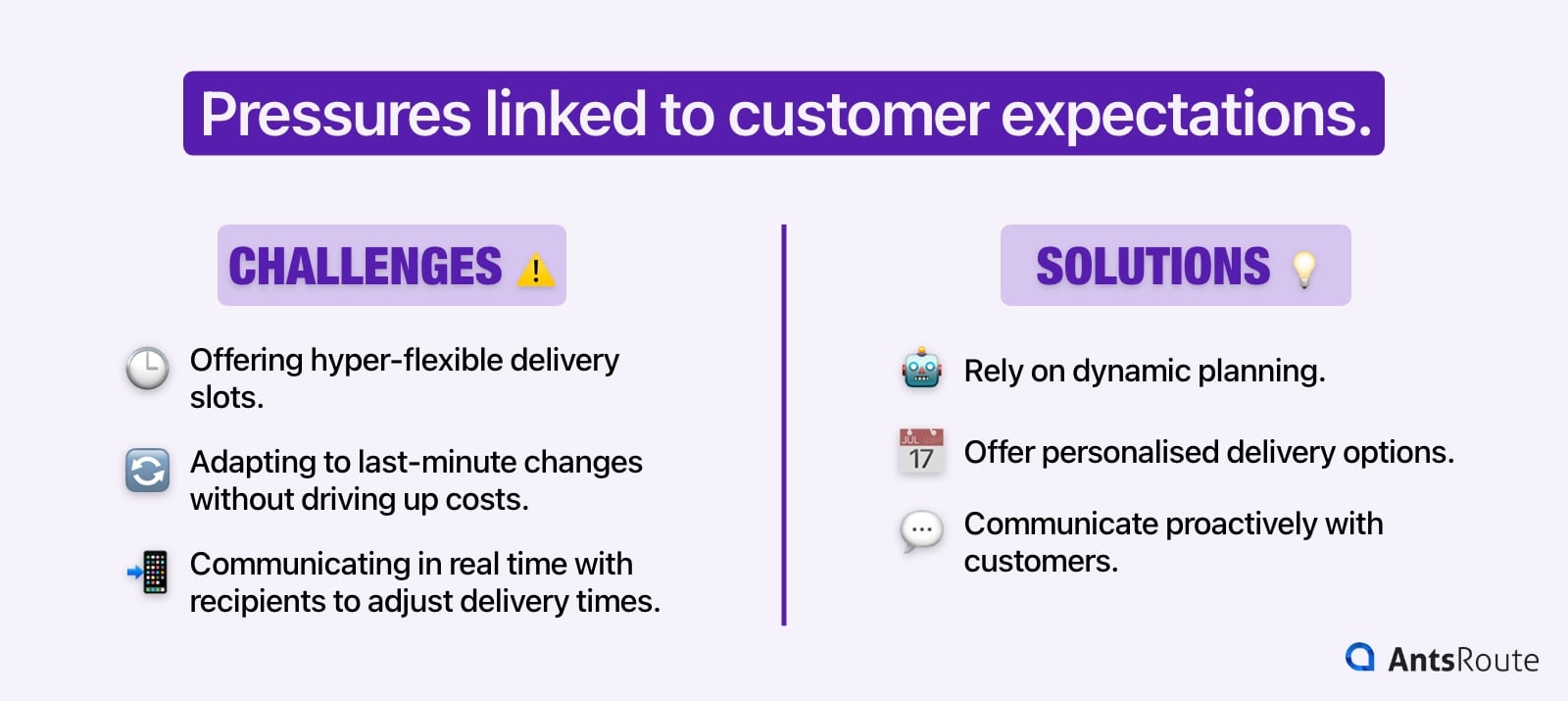
Pressures linked to customer expectations (challenges + solutions).
3. Restricted access in urban areas
Delivering a parcel in the heart of the city in 2025 can sometimes seem like a military obstacle course. With pedestrianised streets, low-emission zones (LEZs), time restrictions for commercial vehicles and huge traffic jams, last-mile delivery is becoming a real headache.
Imagine:
A delivery driver gets stuck in traffic, loses 20 minutes looking for a parking spot, and still has to walk several pedestrian streets, arms full of packages. Meanwhile, customer notifications keep coming in: ‘Your delivery is delayed.’
The major urban challenges today are:
- Traffic restrictions: limited access for combustion engine vehicles in many European cities.
- Parking difficulties: there are very few spaces available for express stops.
- Population density: hundreds of deliveries to be made in a small area, with enormous mobility constraints.
✅ Effective solutions to overcome these challenges:
- Setting up urban micro-hubs: small warehouses in city centres for fast redistribution by bike or on foot.
- Adopting environmentally-friendly means of transport: electric cargo bikes, delivery tricycles, electric scooters.
- Optimise delivery times: favour very early morning or late evening slots, outside peak traffic periods.
☝️ An inspiring example:
In Paris, several innovative logistics companies are now using river logistics bases combined with cargo bike deliveries to reach historic centres without polluting or wasting time. The result: delivery times halved in the most congested areas!
Visually speaking, modern urban delivery could be compared to a game of chess in motion: every move has to be calculated, strategic and anticipated.
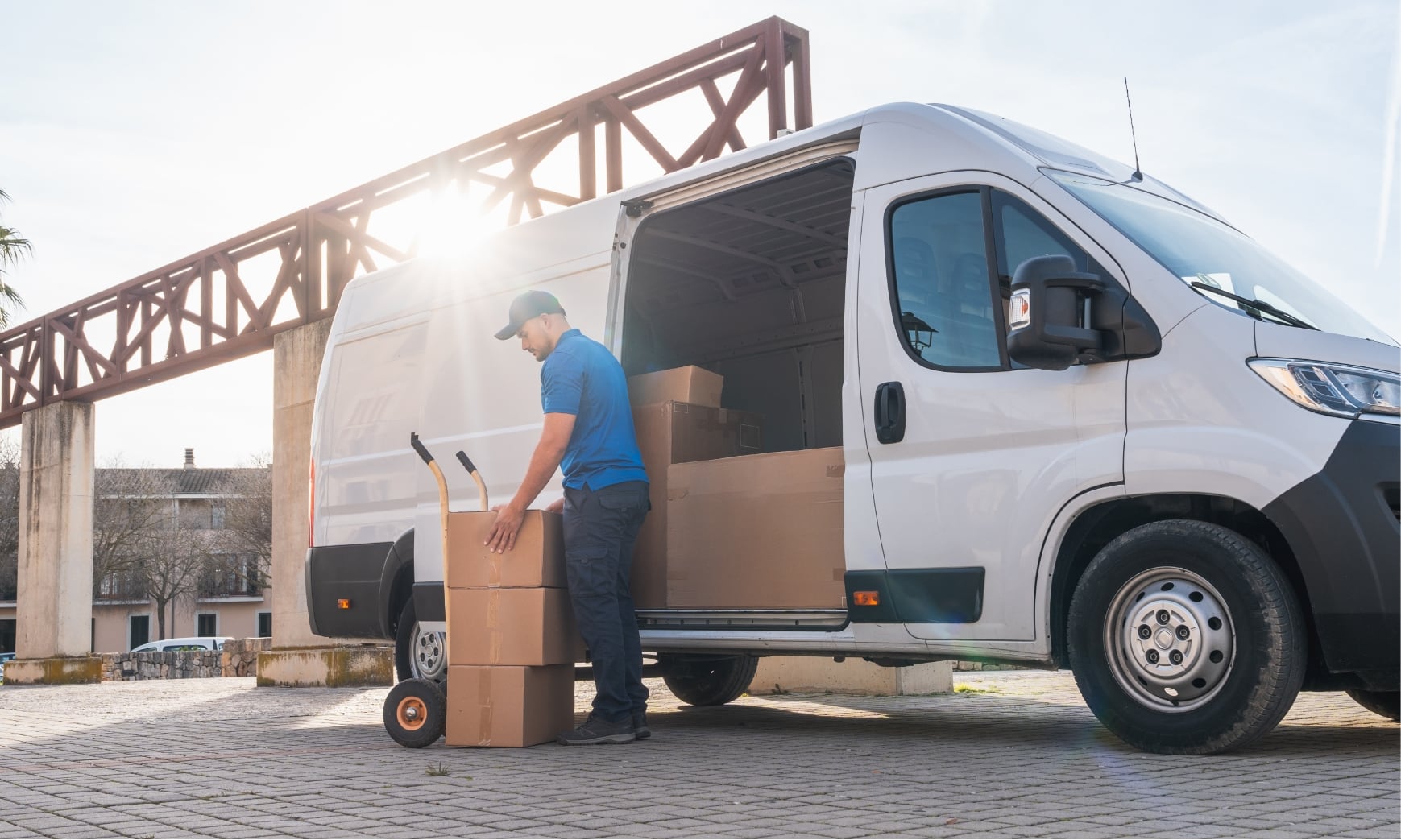
Last-mile delivery in urban areas is a real headache.
4. Problems relating to failed deliveries
Imagine: a delivery driver arrives at a closed door after having driven all over the city, juggled with traffic and meticulously respected his time slot. The result: no recipient, a non-delivery notice to fill in, rescheduling to manage… and immediate extra costs for the company.
In 2025, when last-mile delivery is more demanding than ever, failed deliveries have become enemy No. 1 of profitability.
Why do so many deliveries fail?
- Recipient absent or unavailable.
- Incorrect or inaccurate address.
- Impossible to access the building (door code, absent doorman, etc.).
Direct consequences:
- Additional costs (second visit, customer service, temporary storage).
- Negative impact on the customer experience (and therefore on loyalty).
- Erosion of brand image (because for customers, failure is rarely their fault).
✅ Solutions to avoid delivery failure:
- Set up real-time tracking to enable customers to adjust their availability according to when the delivery driver arrives.
- Offer simple re-delivery options: choice of alternative time slots, delivery to a parcel pick-up point, secure deposit.
- Confirm addresses automatically before dispatch using address validation tools.
For example, AntsRoute offers an innovative system enabling customers to confirm and reschedule their delivery and track the arrival of their driver in real time.
☝️ A case in point:
A computer hardware retailer reduced its delivery failures by 30% by introducing an SMS alert system one hour before the delivery driver’s arrival, with the option for the customer to postpone or change the address instantly.
We could compare a delivery without customer confirmation to ‘sending a bottle into the sea’: a lot of effort, but no certainty that it will reach its destination. Conversely, with proactive communication tools, every delivery becomes a ‘soft landing’.
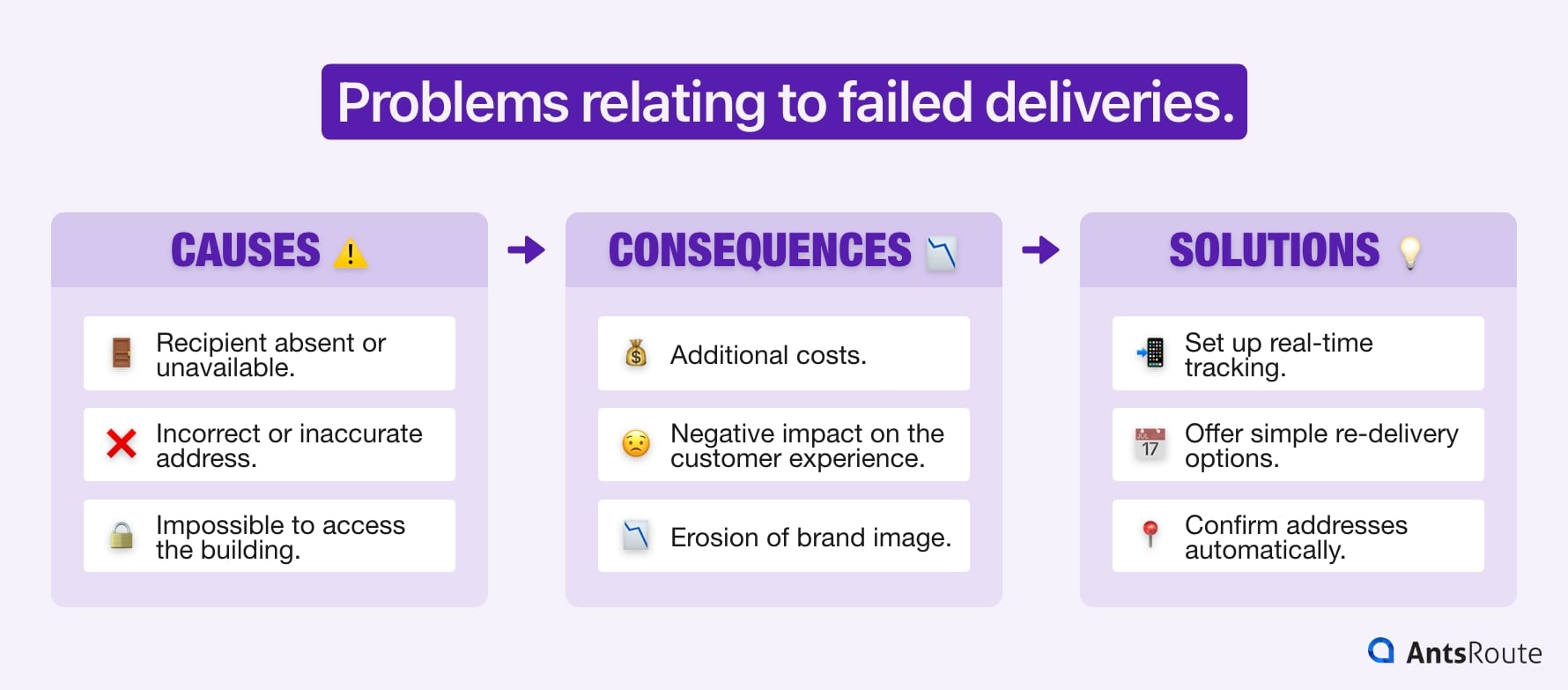
Last-mile problems relating to failed deliveries (causes + consequences + solutions).
5. Poor route planning
Imagine yourself at the wheel of a delivery van, your GPS showing you a route that, at first glance, seems logical. But before you know it, you find yourself stuck in a huge traffic jam, driving around three roads that have been closed off for roadworks, and ending up losing almost an hour on your delivery route.
This scenario, unfortunately still too common in 2025, illustrates one of the major scourges of last-mile delivery: poor route planning.
Why is conventional planning no longer sufficient?
- Real-time traffic data (traffic jams, accidents) change from minute to minute.
- Temporary access restrictions (markets, events, building sites) make standard plans obsolete.
- The density of deliveries requires complex optimisations that only algorithmic processing can truly master.
Consequences of poor planning:
- Longer routes and more overtime for delivery personnel.
- Significant increase in operating costs.
- Repeated delays and unhappy customers.
✅ Solutions for intelligent planning:
- Use route optimisation software incorporating real-time traffic, weather and accessibility data.
- Update routes during the day using adaptive algorithms (dynamic rerouting).
- Regularly analysing key performance indicators (KPIs) to adjust logistics mapping in line with changes in cities.
By using intelligent tools like AntsRoute, you can adapt your routes in real time according to traffic, emergencies or last-minute cancellations, ensuring more efficient and economical routes.
☝️ An inspiring case study:
An SME specialising in the delivery of medical equipment has integrated a dynamic optimisation solution. The result: a 25% reduction in the average journey time per route and less stressed drivers – with fewer unforeseen incidents.
Route planning without dynamic data is like sailing into a storm with an old treasure map. Conversely, equipping yourself with modern tools is like driving with radar and precision GPS, avoiding obstacles before you even see them.
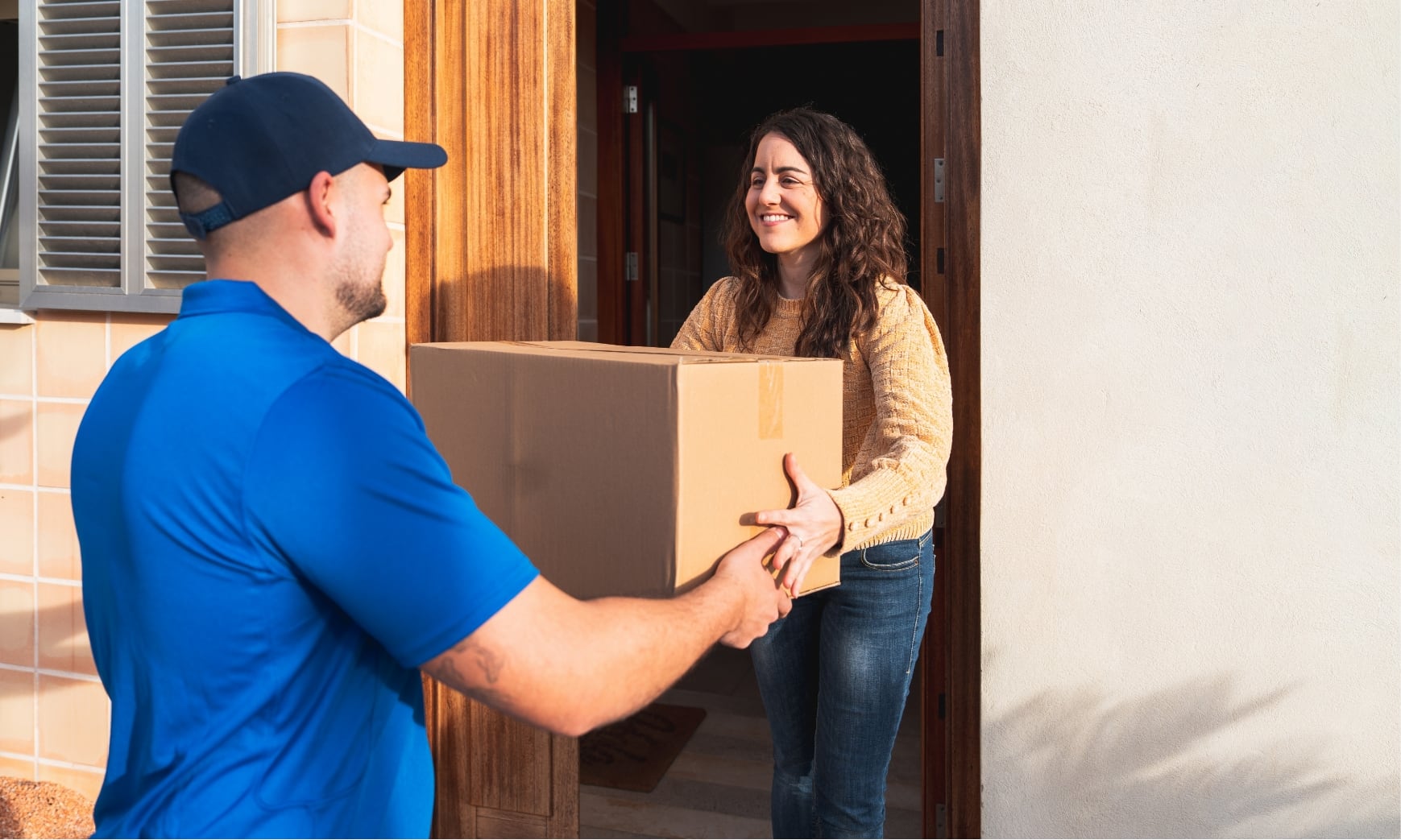
Dynamic route planning improves the customer experience.
6. Complex management of product returns
At first sight, a return may seem harmless: a dissatisfied customer sends back an item, and that’s it. But when these returns pile up by the hundreds, they become a real logistics headache that disrupts the whole organisation of last-mile delivery.
In 2025, managing returns has become a major challenge, particularly for sectors such as e-commerce, fashion and consumer electronics, where the return rate can be as high as 30% of orders.
Why do returns complicate last-mile delivery so much?
- They require reverse flows: the product has to be collected, transported, inspected, returned to stock or recycled.
- They generate additional costs: transport, inspection, repackaging.
- They disrupt initial route planning, as return collections are often unpredictable.
Direct consequences:
- Overloading of warehouses and a slowdown in new deliveries.
- Longer repayment or exchange deadlines for customers.
- More complex customer relations, with the risk of dissatisfaction if returns are poorly managed.
✅ Solutions for better returns management:
- Set up smooth, automated returns processes via mobile applications or printable QR codes.
- Use parcel drop-off points or lockers to centralise collections and limit the number of unsuccessful home pick-ups.
- Analyse the causes of returns (incorrect sizes, inaccurate descriptions, etc.) to reduce their volume at source.
☝️ An example in practice:
An online clothing retailer has introduced an ultra-simplified returns process, with drop-off at a pick-up point and reimbursement triggered as soon as the parcel is scanned. The result: a 22% increase in customer satisfaction and a significant reduction in returns processing costs.
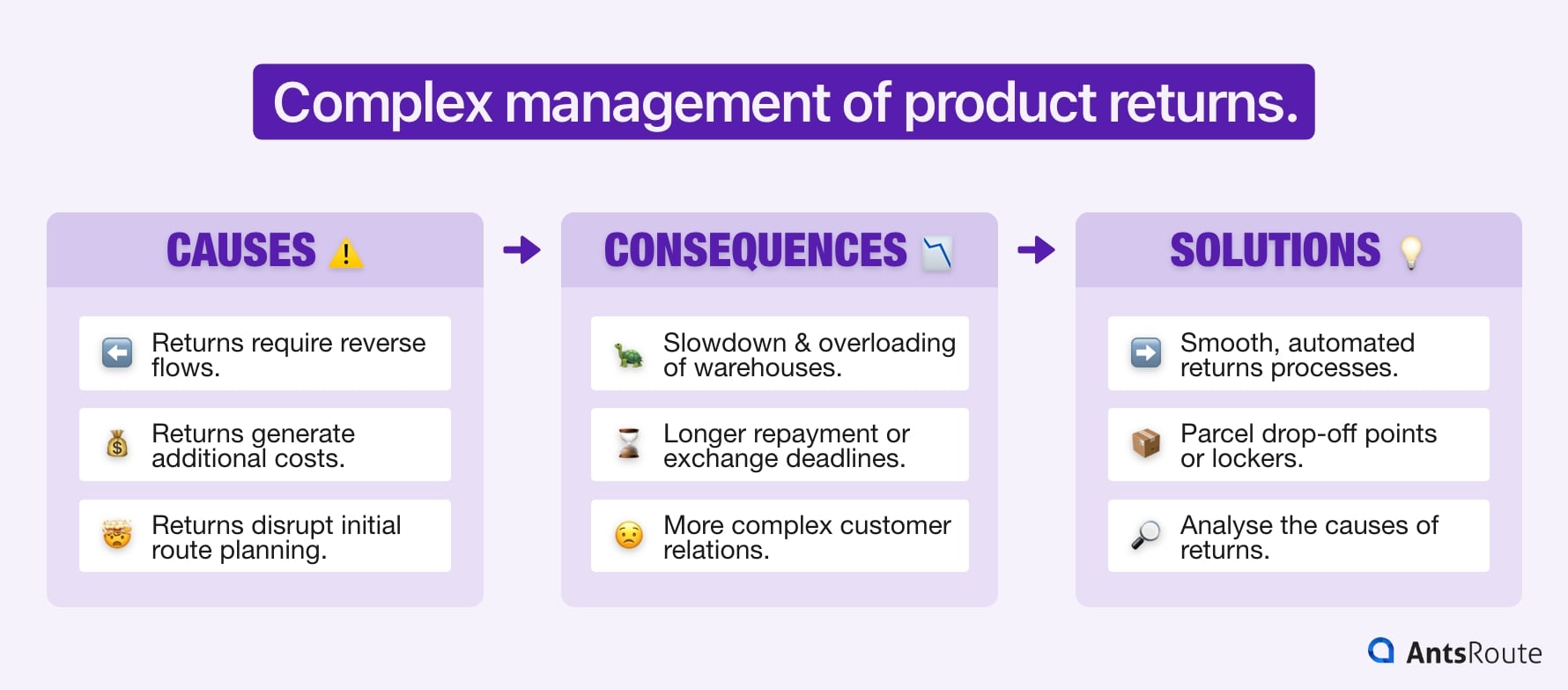
The complex management of product returns (causes, consequences and solutions).
7. Environmental pressures and societal expectations
In 2025, delivering quickly is no longer enough: you also have to deliver in an environmentally-friendly way.
Consumers, cities and even legislators are making clear demands: reducing the carbon footprint of last-mile delivery is no longer an option, it’s a moral, commercial and regulatory obligation.
The environmental challenges of last-mile delivery are numerous:
- Urban pollution exacerbated by conventional commercial vehicles.
- Increasingly strict environmental standards (low-emission zones, traffic bans on combustion engines).
- Social expectations: 70% of European consumers say they prefer brands that are committed to the environment.
Consequences without action:
- Loss of access to certain urban centres.
- Risk of fines or penalties for non-compliance.
- Damage to brand image in the eyes of customers who are increasingly sensitive to CSR (Corporate Social Responsibility).
✅ Solutions for reducing environmental impact and moving logistics towards an eco-responsible model:
- Electrification of the delivery fleet: adopting electric or hybrid vehicles for urban areas.
- Deployment of urban micro-depots to avoid long, polluting journeys.
- Intelligent route optimisation to reduce the number of kilometres travelled empty.
☝️ An inspiring example:
DPD, a major delivery company in the UK, has deployed over 1,500 electric vehicles for its urban deliveries, helping the company significantly cut emissions and move towards its goal of becoming the UK’s most sustainable delivery service.
Moving towards an eco-friendly logistics model involves a top-to-bottom transformation of working methods. This means adopting practices that are more sustainable, more efficient and better aligned with current environmental and regulatory requirements.
Summary table of last-mile challenges and solutions
| Challenge | Consequences | Proposed key solution |
| High costs | Increase in logistics costs. | Dynamic route optimisation with AntsRoute and shared deliveries. |
| High customer expectations | Dissatisfaction and loss of loyalty. | Flexible delivery options and real-time communication. |
| Difficult urban access | Delays and fines. | Micro-hubs and green fleets. |
| Failed deliveries | Additional costs and dissatisfaction. | Real-time tracking and intelligent re-delivery. |
| Poor planning | Delays, wasted resources. | Route optimisation software and performance analysis. |
| Complex returns management | Logistics disorganisation. | Simplification and integration of returns with drop-off points and lockers. |
| Environmental pressures | Regulatory risks and a tarnished image. | Eco-friendly last-mile delivery and carbon footprint monitoring. |
Last-mile delivery in 2025 looks like a veritable logistics battlefield, where every detail counts: optimising costs, responding to increasingly hurried customers, navigating city centres that have become a nightmare, getting every delivery right first time, totally rethinking route planning, mastering the complexity of returns, and making a firm commitment to the environment.
Faced with these 7 major challenges, one thing is clear: the status quo is no longer an option.
Any company that wants to remain competitive must adopt agile, technological and eco-friendly solutions to transform these obstacles into genuine levers for growth and loyalty.
Acting today means building the logistics of tomorrow.
It means offering our customers not only products, but also seamless, reliable and sustainable experiences.
FAQ: Frequently Asked Questions
AI will play a key role in 2025 in anticipating traffic jams, automatically recalculating routes in the event of unforeseen circumstances, predicting order volumes, and even optimising time slots based on customer behaviour.
Solutions like AntsRoute incorporate advanced algorithms to make route planning smarter and more responsive.
Thanks to dynamic optimisation (based on real-time data), companies can offer more precise delivery schedules, avoid delays due to urban hazards, and offer immediate rescheduling in the event of absence.
This reinforces the reliability perceived by customers and increases their loyalty.
Last-mile delivery accounts for up to 25% of CO2 emissions in some cities. To reduce this impact, it is crucial to optimise routes, consolidate orders, use electric vehicles and integrate sustainable logistics solutions such as those offered by AntsRoute.
Major trends include the rise of autonomous delivery (drones, robots), the spread of AI-based predictive optimisation, and the emergence of new collaborative models (logistics crowdsourcing, cross-company pooling).
Companies that adapt to these innovations today will take a major strategic lead in their markets.
Want to take action?
Try AntsRoute for free for 7 days: the SaaS route planning and optimisation solution designed to overcome last-mile logistics challenges for SMEs and large groups alike.
Free 7-day trial | No credit card required
Contenu
- 1. High cost of last-mile delivery
- 2. Pressures linked to customer expectations (fast, flexible delivery)
- 3. Restricted access in urban areas
- 4. Problems relating to failed deliveries
- 5. Poor route planning
- 6. Complex management of product returns
- 7. Environmental pressures and societal expectations
- Summary table of last-mile challenges and solutions
- FAQ: Frequently Asked Questions

